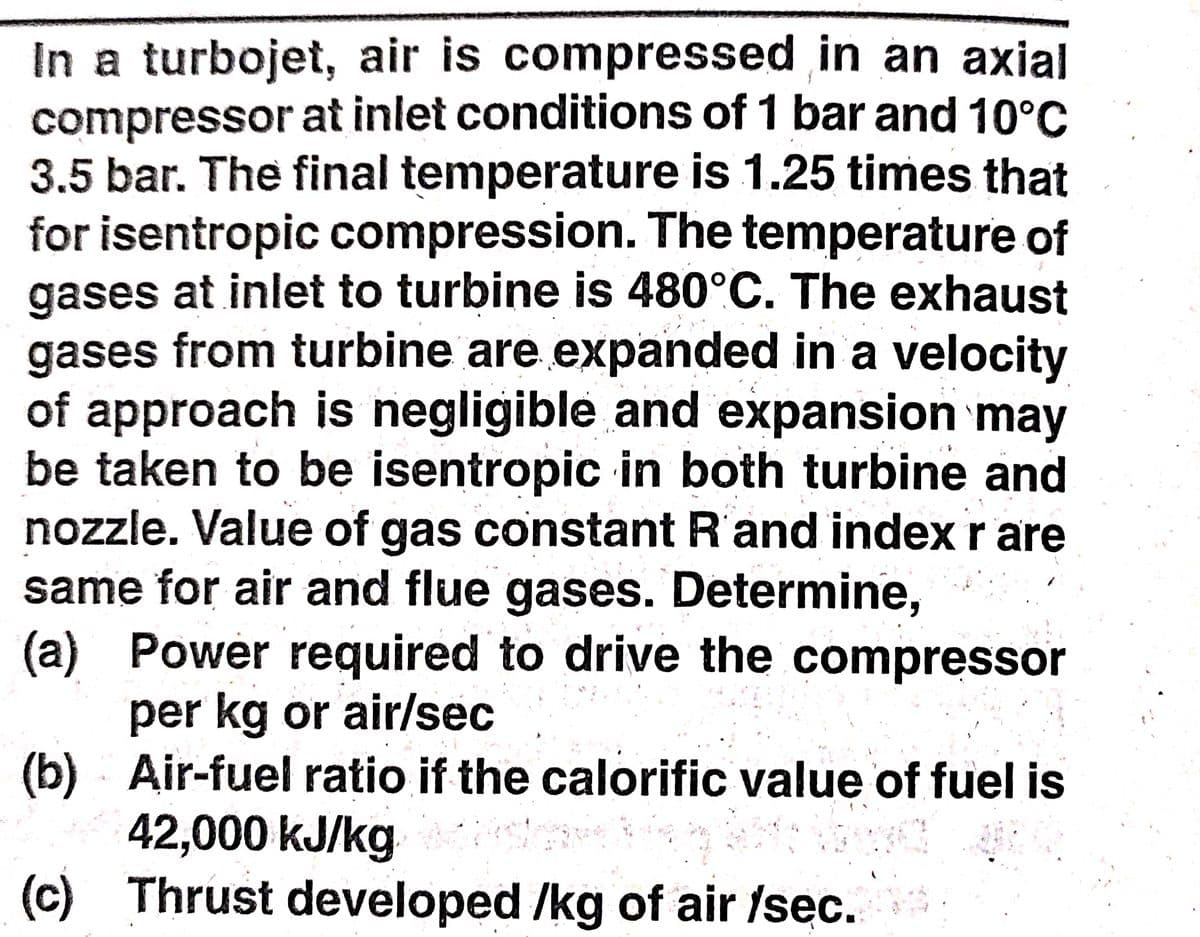In a turbojet, air is compressed in an axial compressor at inlet conditions of 1 bar and 10°C 3.5 bar. The final temperature is 1.25 times that for isentropic compression. The temperature of gases at inlet to turbine is 480°C. The exhaust gases from turbine are expanded in a velocity of approach is negligible and expansion may be taken to be isentropic in both turbine and nozzle. Value of gas constant R'and index r are same for air and flue gases. Determine, (a) Power required to drive the compressor per kg or air/sec (b) Air-fuel ratio if the calorific value of fuel is 42,000 kJ/kg (c) Thrust developed /kg of air fsec.
In a turbojet, air is compressed in an axial compressor at inlet conditions of 1 bar and 10°C 3.5 bar. The final temperature is 1.25 times that for isentropic compression. The temperature of gases at inlet to turbine is 480°C. The exhaust gases from turbine are expanded in a velocity of approach is negligible and expansion may be taken to be isentropic in both turbine and nozzle. Value of gas constant R'and index r are same for air and flue gases. Determine, (a) Power required to drive the compressor per kg or air/sec (b) Air-fuel ratio if the calorific value of fuel is 42,000 kJ/kg (c) Thrust developed /kg of air fsec.
Elements Of Electromagnetics
7th Edition
ISBN:9780190698614
Author:Sadiku, Matthew N. O.
Publisher:Sadiku, Matthew N. O.
ChapterMA: Math Assessment
Section: Chapter Questions
Problem 1.1MA
Related questions
Question

Transcribed Image Text:In a turbojet, air is compressed in an axial
compressor at inlet conditions of 1 bar and 10°C
3.5 bar. The final temperature is 1.25 times that
for isentropic compression. The temperature of
gases at inlet to turbine is 480°C. The exhaust
gases from turbine are expanded in a velocity
of approach is negligible and expansion may
be taken to be isentropic in both turbine and
nozzle. Value of gas constant R'and index r are
same for air and flue gases. Determine,
(a) Power required to drive the compressor
per kg or air/sec
(b) Air-fuel ratio if the calorific value of fuel is
42,000 kJ/kg
(c) Thrust developed /kg of air fsec.
Expert Solution
This question has been solved!
Explore an expertly crafted, step-by-step solution for a thorough understanding of key concepts.
Step by step
Solved in 4 steps with 3 images

Knowledge Booster
Learn more about
Need a deep-dive on the concept behind this application? Look no further. Learn more about this topic, mechanical-engineering and related others by exploring similar questions and additional content below.Recommended textbooks for you

Elements Of Electromagnetics
Mechanical Engineering
ISBN:
9780190698614
Author:
Sadiku, Matthew N. O.
Publisher:
Oxford University Press

Mechanics of Materials (10th Edition)
Mechanical Engineering
ISBN:
9780134319650
Author:
Russell C. Hibbeler
Publisher:
PEARSON

Thermodynamics: An Engineering Approach
Mechanical Engineering
ISBN:
9781259822674
Author:
Yunus A. Cengel Dr., Michael A. Boles
Publisher:
McGraw-Hill Education

Elements Of Electromagnetics
Mechanical Engineering
ISBN:
9780190698614
Author:
Sadiku, Matthew N. O.
Publisher:
Oxford University Press

Mechanics of Materials (10th Edition)
Mechanical Engineering
ISBN:
9780134319650
Author:
Russell C. Hibbeler
Publisher:
PEARSON

Thermodynamics: An Engineering Approach
Mechanical Engineering
ISBN:
9781259822674
Author:
Yunus A. Cengel Dr., Michael A. Boles
Publisher:
McGraw-Hill Education

Control Systems Engineering
Mechanical Engineering
ISBN:
9781118170519
Author:
Norman S. Nise
Publisher:
WILEY

Mechanics of Materials (MindTap Course List)
Mechanical Engineering
ISBN:
9781337093347
Author:
Barry J. Goodno, James M. Gere
Publisher:
Cengage Learning

Engineering Mechanics: Statics
Mechanical Engineering
ISBN:
9781118807330
Author:
James L. Meriam, L. G. Kraige, J. N. Bolton
Publisher:
WILEY